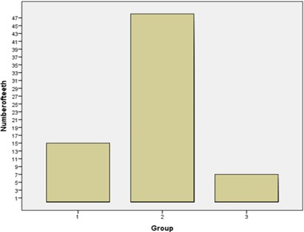Abstract
The success of endodontic therapy is 53-96%. It depends on a multitude of factors like tooth type, preoperative apical status, method of obturation, irrigation, coronal seal permanent restoration. Grossly decayed endodontically treated teeth are often restored with post and core. Apical microleakage can lead to failure of the endodontic therapy. So, the aim of this study was to measure the distance between the post and residual gutta-percha in cast post cases. Dental records and radiographs of patients treated with cast post cases were obtained from DIAS (From June 2019- March 2020) examined by the same examiner. Patients were categorized into three groups based on the distance between the remaining obturation material and post. A total of 70 cases were examined. Out of which 21% of cases belonged to Group I and 68% of the cases were categorized into Group II. Within the limitation of the study, most of the cases had an average dead space of 0.1-2 mm (68%). Within the limitation of the study, most of the cases had an average dead space of 0.1-2 mm (68%). The dead space occurring after a post-restoration can be a good shelter for the microorganisms. So, radiographic confirmation of the post adaptation should be performed before cementation of all kinds of posts.
Full text article
Authors

This work is licensed under a Creative Commons Attribution-NonCommercial-NoDerivatives 4.0 International License.

